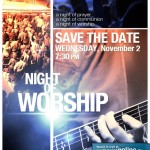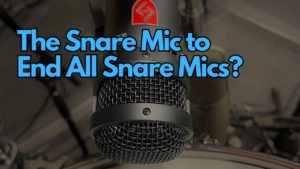
Workflow – Night of Worship Fall 2011: Tuesday

Preparations for the Night of Worship continued on Tuesday. The day after rehearsal is typically reserved for virtual soundcheck. Virtual soundcheck gives me the ability to endlessly repeat songs and sections of songs to work on the mix. I’ve been using it for more than five years now, and I can’t emphasize enough how powerful a tool this has been for me and the rest of us mixing at NP campuses.
I have a couple goals whenever I’m using virtual soundcheck. My primary goal is mix refinement. While I try and get things in the ballpark as much as I can during rehearsal, sometimes it can be a little easier to drill down on some things when time isn’t an issue. I spent the first part of Tuesday morning working on vocals and guitars to get them to sit together better in the frequency spectrum. Once I had that where I was comfortable, I started going song by song refining balances.
I believe that a mix is a living breathing thing so my faders won’t sit still during the actual night. However, I want to get everything to a place that sort of sits all right without any moves. This is important because it’s always a possibility that someone or something is going to interrupt me while mixing. Maybe it will be a producer with a change or someone important with a mix note. Ideally there will be no interruptions, but the reality is it happens, and hopefully I can have a baseline balance that works in those events.
Through the course of the balancing process I’m actually balancing a few different things. For starters I’m trying to get the right balance and blend for the song that will give it the most emotional impact. I think some people might consider me a bit more of an audiophile than I actually am. While I want everything to sound the best it can and work on that a lot during this process, I’m really digging more for a balance between some sonic audiophile nirvana and an audio experience that connects with a listener on an emotional level.
Let’s face it, there aren’t a lot of people who will walk out the door talking about how great that one guitar sounded or how clear that keyboard was in the third song. They will, however, walk out the door talking about how great an experience it was. I believe that worship has nothing to do with music because worship is ultimately a heart thing. We’re just using the music to try and point hearts in the right direction. That doesn’t happen if people are standing in rows focusing on how they can pick out every instrument on the stage. It happens when the music is enveloping and emotional. That doesn’t mean there isn’t a more audiophile-ish side to it, though, because I also believe that making it sound great contributes to that emotional impact.
The other part of the balancing process is trying to balance each song against each other. This is more of a holistic thing for the whole night where I’m trying to make the whole thing go somewhere. I don’t want the loudest, biggest mix of the night to be the first thing. There can be big and loud early on, but I don’t want to assault everyone with every song. There needs to be some dynamic to things. This might be little things like making the guitar bed bigger at times or having the kick thump a bit more. These things can’t be arbitrary, though, and they need to fit contextually within the song. The reality is if the band has a great flow to the set, this will come pretty naturally so most of the time I’m really trying to flow with them.
Within this process I also work on customizing some settings for each song. FX are probably the biggest thing I go after in this regard. I could probably get away with just using some generic settings for the whole night, but everything seems to sit better when it’s been tweaked a bit. Aside from FX, I might do some customized EQ settings on keyboards to adjust for the different patches being used throughout the event.
My secondary goals with virtual soundcheck are to learn arrangements and then rehearse the mix. I want to get a feel for who’s playing what and when so that I can get an idea of what I want to emphasize and when. Once I have all the parts figured out, I try and run the songs so that I can get a feel for what I’m going to push and how much I’m going to do it. During this rehearsing I’ll also make notes in the snapshot page that typically revolve around things that I want to make sure I remember. These are especially important to me for nights like this because we get one shot at it so it’s harder to memorize things I would normally remember through repetition. Sometimes these notes remind me of things like a doubled choruses or when to bring in an effect, but they might also give me info on who’s playing a part that might get out of control or hurt if it’s not balanced properly.
One thing that’s important to note is that I try not to go for long stretches of time using virtual soundcheck if I’m using the PA. I’ll mix for a while and then take a break. Sometimes I’ll also switch to headphones and work at lower volumes for a bit. In my workflow I try and find a balance of experiencing what the attenders will experience and keeping from overexposing my own ears. On Tuesday I actually mixed on and off for the morning and spent the afternoon mixing monitors for a rehearsal in our other auditorium. Then after dinner I did a few more touch ups on the mix.
The last thing I’ll add to Tuesday is more of a side note. By the end of the day two songs had been cut, and a new song had been added to replace them.

 Previous Post
Previous Post




I try to mix very dynamically and I`m curious about what kind of dynamic changes you are actually making in the moment. Aside from keeping vox in the pocket, how are you emphasizing choruses? Are your drums and bass fairly static? i tend to find most of the chrous dynamics by pushing eg`s. Do you ever use your full band vca for dynamic rides?
1 more question… I believe you are sometimes mixing into compression on certain groups. Do you find that it impacts you dynamic fader movement? Like, if you want to push drums would you drum vca pull the drum group, or individual drum inputs? Do you feel mixing into compression makes your fader movement more transparent or musical, as apposed to just sounding like a volume change?
As far as dynamic changes, it depends on the song and the band. Most of the time I keep the bass and drums pretty static, but I’ll push fills every once in a while and pull drums back a bit in a verse if it feels like it’s too much.
On choruses I might push up the guitars a bit or maybe pull the keys back. It really depends on what the band is doing. Ideally they’re supplying the dynamics.
I don’t usually use the full band VCA during songs–it is primarily used for transitions.
In terms of mixing into compression, I’m not doing it much anymore on groups or the master, although I have a tape simulator plugin I use on guitars that works a bit like this, though. I guess in some ways when I’m using compression this way, it can help make it harder for me to screw up since it takes a bigger move to push things to extremes.
As far as drums, I have my drum groups assigned to a VCA and I ride that up or down as needed. When I worked off individual faders, I found it affected my parallel compression group too much and changed the sound more than I wanted.